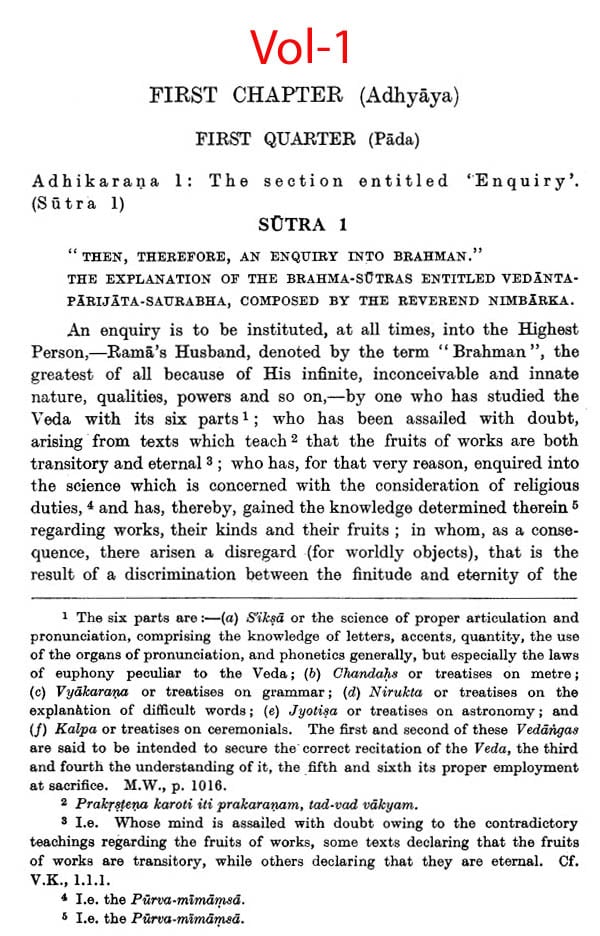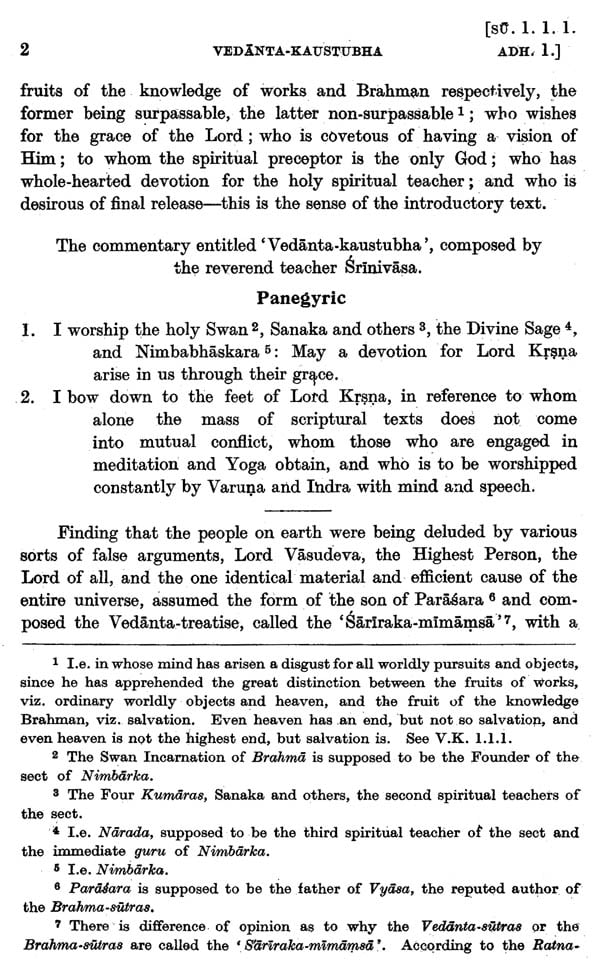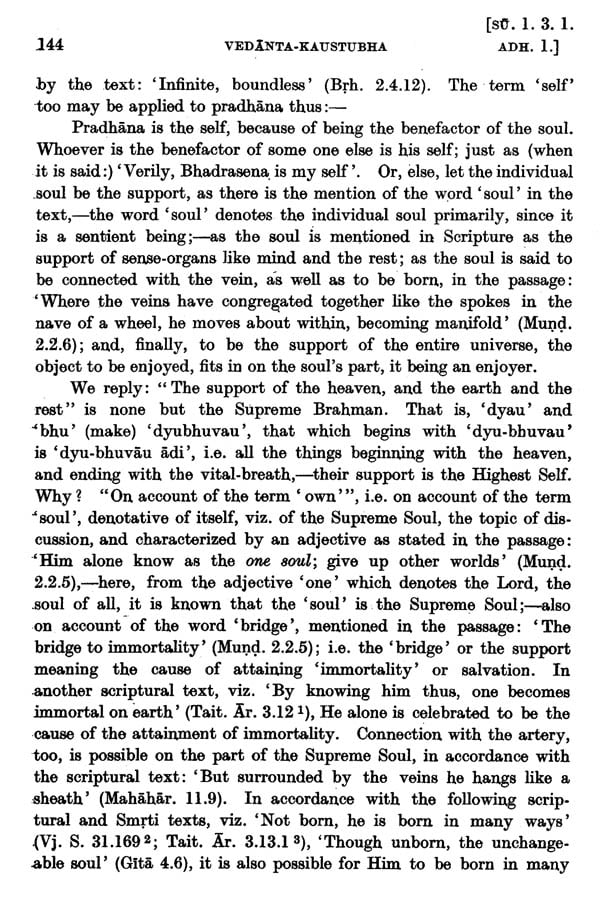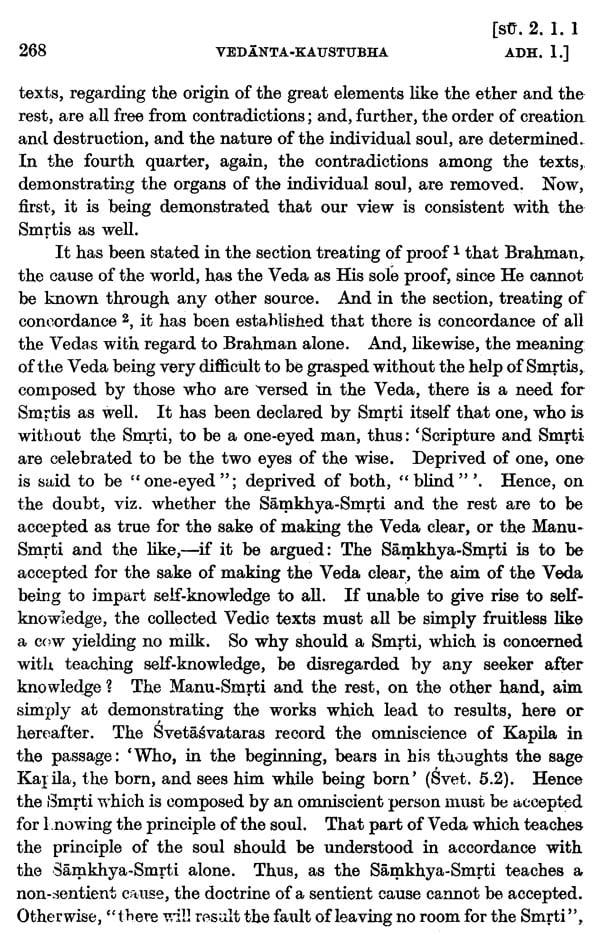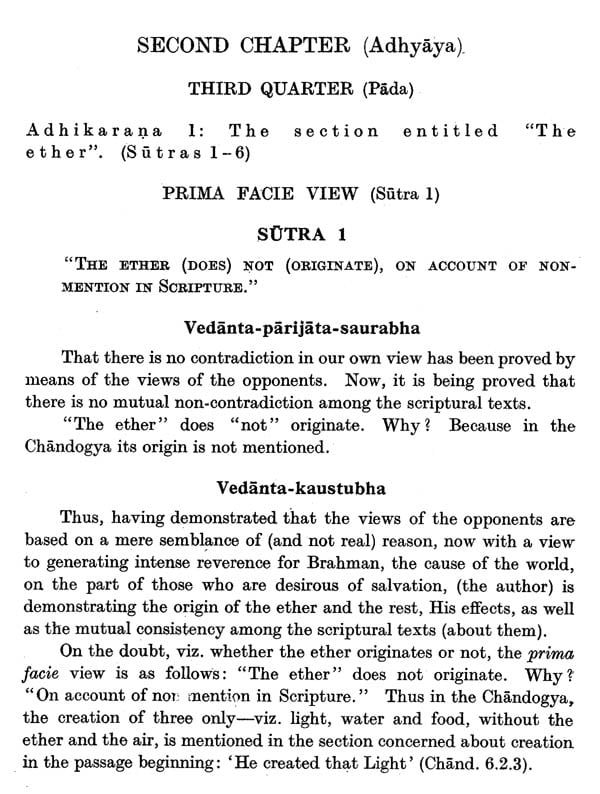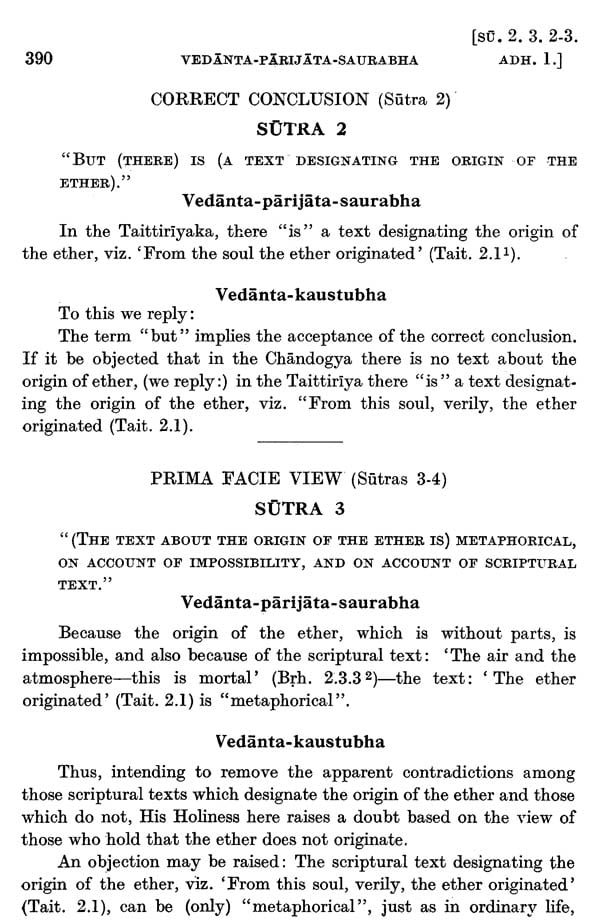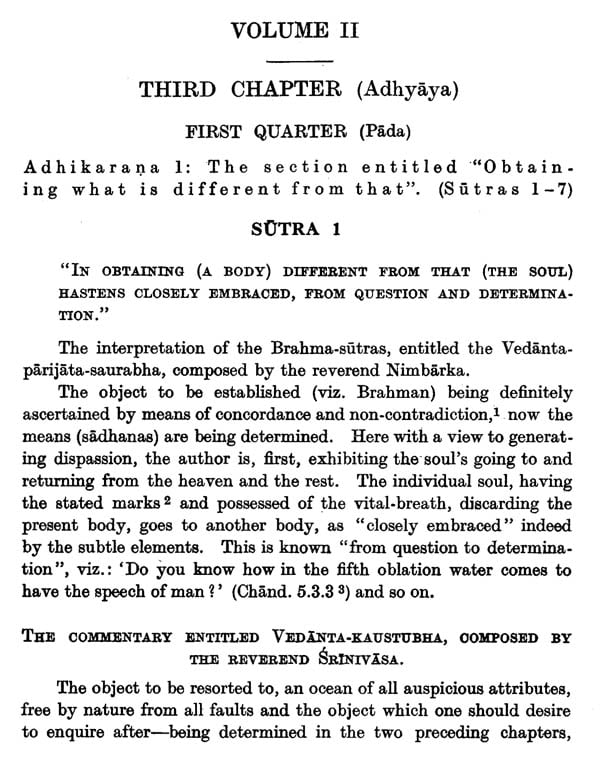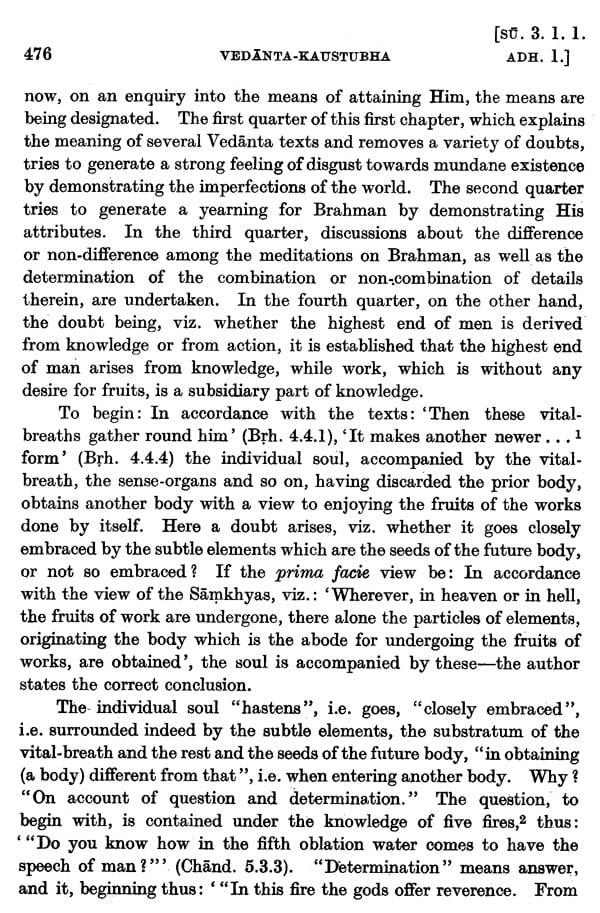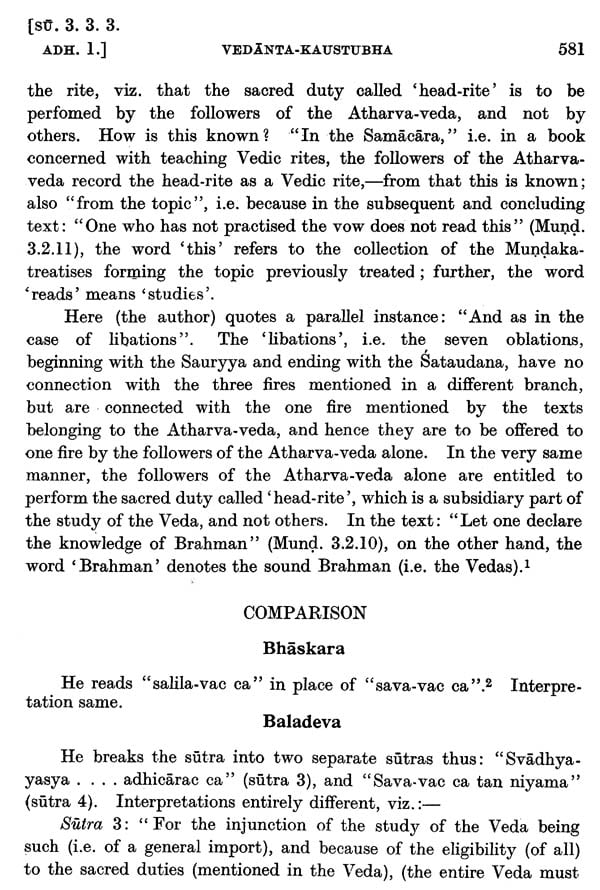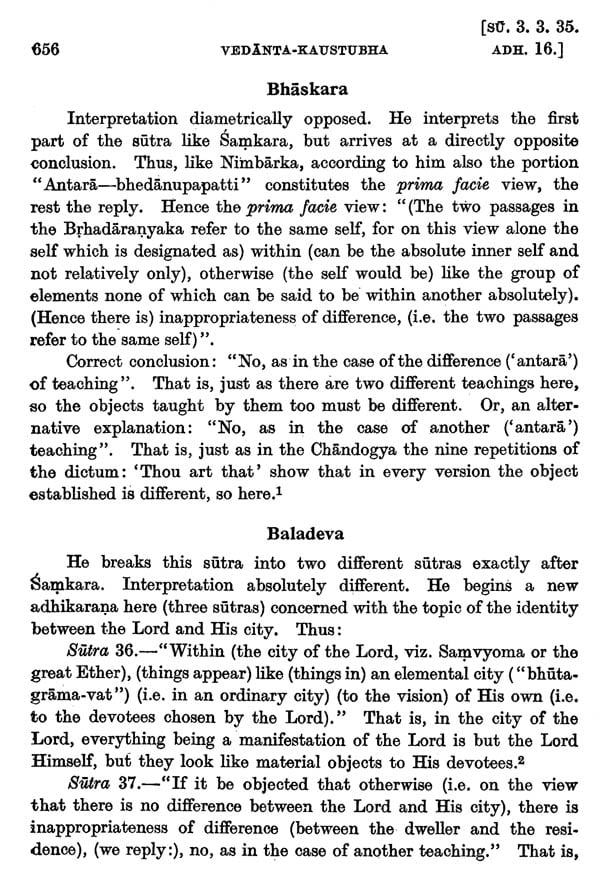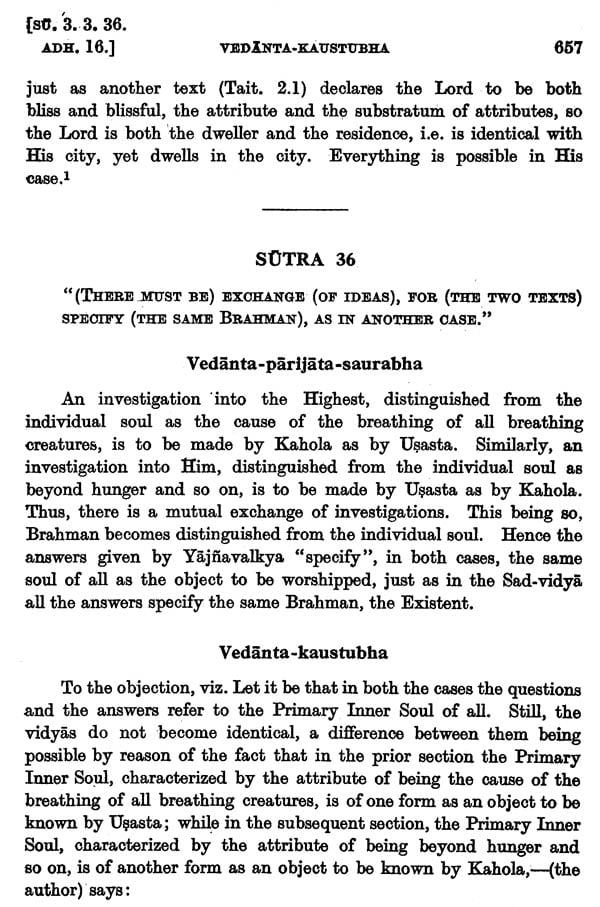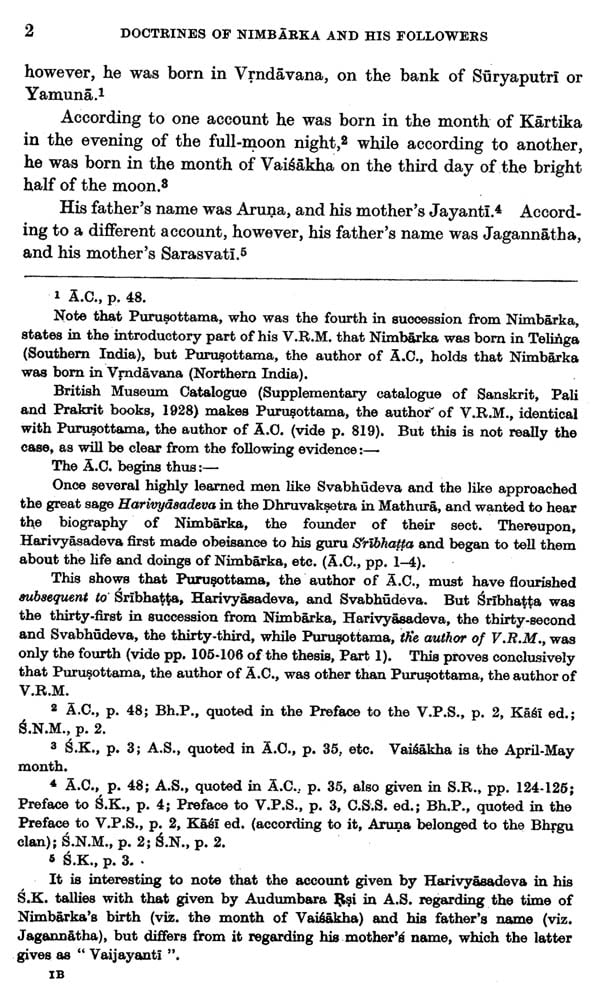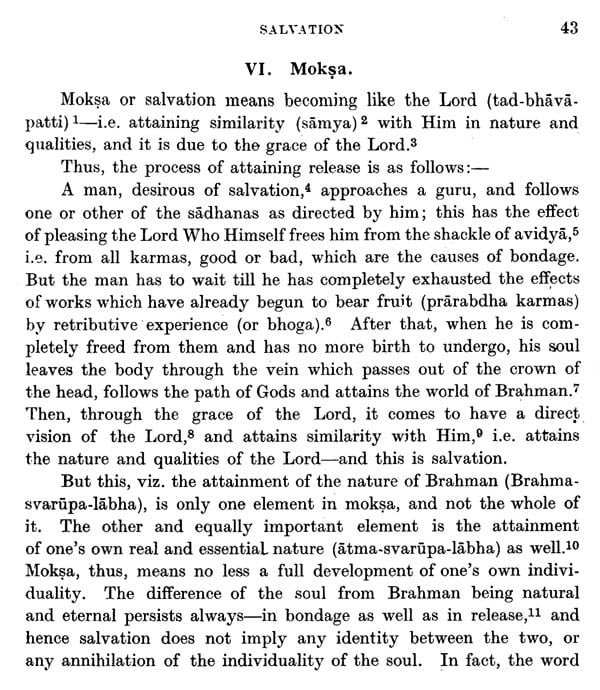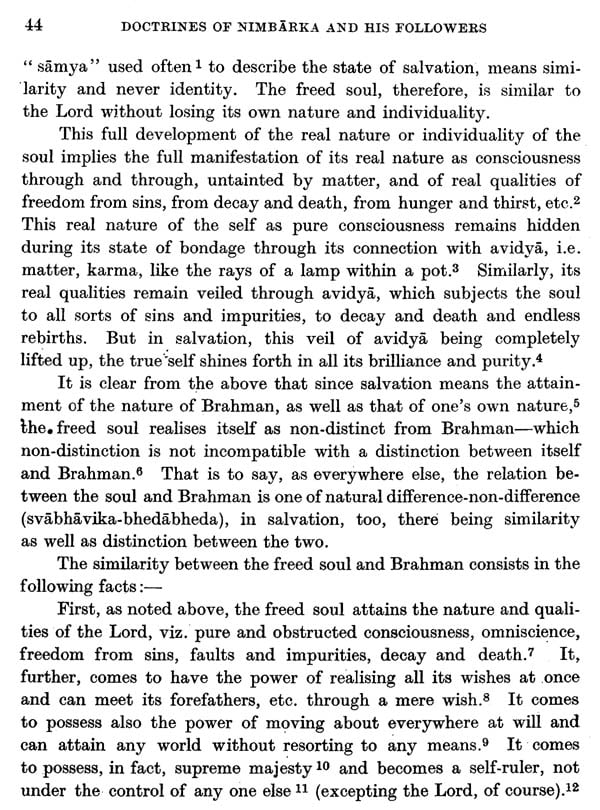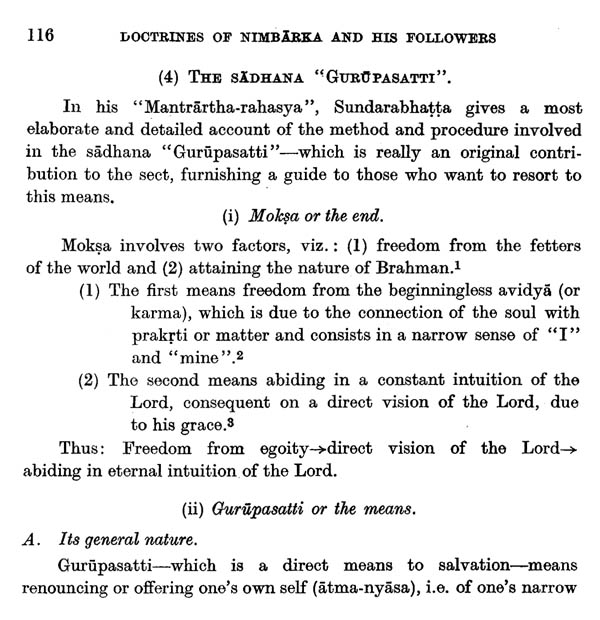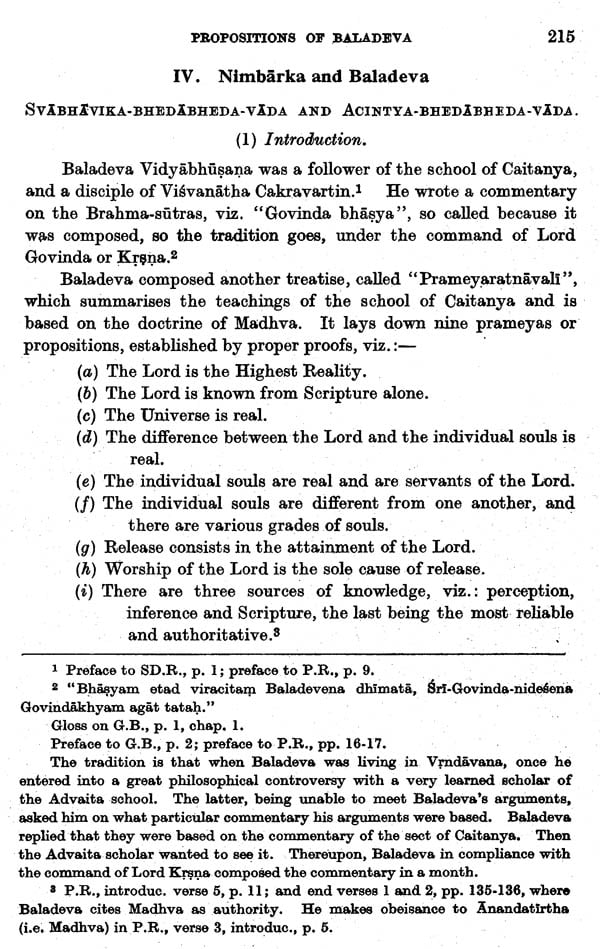
Vedanta-Parijata-Saurabha of Nimbarka and Vedanta-Kaustubha of Srinivasa: Commentaries on the Brahma-Sutras (3 Volumes)
Book Specification
| Item Code: | IDE191 |
| Author: | Translated and Annotated By. Roma Bose |
| Publisher: | MUNSHIRAM MANOHARLAL PUBLISHERS PVT LTD |
| Language: | English |
| Edition: | 2004 |
| ISBN: | 8121511216 |
| Pages: | 1216 |
| Cover: | Hardcover |
| Other Details | 8.8" X 5.8" |
Book Description
From the Jacket:
Nimbarka's commentary on the Brahma-Sutras known as the Vedanta-Parijata-Saurabha, and that of his immediate disciple Srinivasa styled the Vedanta-Kaustubha are the chief works of the school of philosophy associated with the name of Nimbarka. The latter is not, however, a mere commentary on the former, as is sometimes wrongly supposed, but a full exposition of the views expressed I the Vedanta-Parijata-Saurabha which is very terse and concise and is not always clear. Both the treatises are therefore essential for the proper understanding of the doctrine of Nimbarka.
The learned author has given a lucid and comprehensive exposition of the doctrinal as well as the historical problems of the Nimbarka school in its entirety. Opening with a brief survey of the life of Nimbarka, the author discusses briefly the date as well as the specific works of the great philosopher. The rest of the book is devoted to a detailed analysis of the book is devoted to a detailed analysis of the doctrines of Nimbarka and his followers.
Volume - 3
| 1. | Life of Nimbarka | 1 |
| 2. | Works of Nimbarka | 8 |
| 3. | Date of Nimbarka | 14 |
| 4. | Doctrine of Nimbarka | 18 |
| Brahman | 18 | |
| The Cit: the Jiva | 27 | |
| Nature, size number and kinds of the Jiva | 27 | |
| Different States of the Jiva: Jagrat, Svapna, Susupti, Murccha and Marana | 33 | |
| Different destinies of the Jiva: Svarga, Naraka and Apavarga | 34 | |
| The Acit: Prakrta, Aprakrta, Kala | 39 | |
| Relation between Brahman, Cit and Acit | 40 | |
| Criticism of other schools | 42 | |
| Moksa | 43 | |
| Ethics: the Sadhanas | 46 | |
| (i) Karma | 46 | |
| (ii) Vidya | 46 | |
| Nature of Vidya and its relation to Karma | 46 | |
| Adhikarins of Vidya | 48 | |
| Rise of Vidya | 50 | |
| (iii) Upasana or Dhyana | 50 | |
| Mode of Meditation | 50 | |
| Posture of Meditation | 50 | |
| Place of Meditation | 50 | |
| Time of Meditation | 51 | |
| Fruit of Meditation | 51 | |
| Kinds of Meditation | 51 | |
| Adhikarins of Meditation | 53 | |
| Upasana and Bhakti | 53 | |
| (iv) Prapatti | 54 | |
| Its general nature and factors | 54 | |
| Adhikarins of Prapatti | 55 | |
| (v) Gurupasatti | 55 | |
| Its general nature | 55 | |
| Adhikarins of Gurupasatti | 56 | |
| Sahakarins to the Sadhanas | 57 | |
| Virodhins to the Sadhanas | 58 | |
| Conclusion | 61 | |
| Theology | 63 | |
| 5. | Followers of Nimbarka | 65 |
| Introduction | 65 | |
| (1) Srinivasacarya | 66 | |
| Life and Date | 66 | |
| Works | 67 | |
| Doctrine | 68 | |
| (2) Visvacarya | 69 | |
| (3) Purusottamacarya | 70 | |
| Life and Date | 70 | |
| Works | 70 | |
| Doctrine | 70 | |
| Trinity of Reals | 71 | |
| Brahman | 71 | |
| His nature and qualities | 71 | |
| His forms and manifestations | 75 | |
| Criticism of rival theories | 77 | |
| Nirguana-vada and Nirvisesa-vada | 77 | |
| Aprameyatva-vada | 78 | |
| The Cit | 78 | |
| Its nature, size, number and kinds | 78 | |
| Criticism of rival theories | 84 | |
| Pratibimba-vada | 84 | |
| Avaccheda-vada | 84 | |
| Sarva-gatatma-vada | 86 | |
| Eka-jiva-vada | 87 | |
| The Acit | 87 | |
| Prakrta | 88 | |
| Kala | 94 | |
| Aprakrta | 95 | |
| Criticism of rival theories | 96 | |
| Vivarta-vada | 96 | |
| Epistemology | 97 | |
| Reconciliation of Abheda and bheda texts | 99 | |
| Relation between Brahman Cit and Acit | 99 | |
| Interpretation of the text 'Tat tvam asi' | 100 | |
| The Sadhanas | 100 | |
| The five sadhanas | 100 | |
| Theory of Grace | 105 | |
| Moksa | 107 | |
| (4) Devacarya | 107 | |
| Life and Date | 107 | |
| Works | 108 | |
| Doctrine | 108 | |
| Brahman | 108 | |
| The Cit | 110 | |
| The Acit | 110 | |
| Relation between them | 110 | |
| Moksa | 113 | |
| Sadhanas | 114 | |
| (5) Sundarabhatta | 115 | |
| Life and Date | 115 | |
| Work | 115 | |
| Doctrine | 115 | |
| Moksa | 116 | |
| Sadhana: Gurupasatti | 116 | |
| Its general nature | 116 | |
| Qualifications of Guru and Sisya | 118 | |
| Its successive stage | 119 | |
| (6) Kesavakasmiribhatta | 122 | |
| Life and Date | 122 | |
| WorksLife | 123 | |
| Doctrine | 124 | |
| Criticism of Advaita-vada | 124 | |
| Advaita View of Brahman | 124 | |
| Nirvisesa-vada | 124 | |
| Advaita view of jiva | 126 | |
| Pratibimba-vada | 126 | |
| Avaccheda-vada | 126 | |
| Eka-jiva-vada | 127 | |
| Akartrtva-vada | 127 | |
| Advaita view of jagat | 127 | |
| Vivarta-vada | 127 | |
| Advaita view of Moksa | 130 | |
| General criticism | 130 | |
| Jivan-mukti-vada | 131 | |
| (7) Sribhatta | 132 | |
| (8) Harivyasadeva | 133 | |
| Life and Date | 133 | |
| Works | 133 | |
| Doctrine | 133 | |
| Brahman | 134 | |
| The Cit | 135 | |
| Its nature, etc. | 135 | |
| Criticism of Advaita view of Jiva | 136 | |
| Pratibimba-vada | 136 | |
| Avaccheda-vada | 136 | |
| The Acit | 136 | |
| Its nature, etc. | 136 | |
| Criticism of the Advaita view of Jagat | 136 | |
| Adhyasa-vada | 136 | |
| Relation between Brahman, Cit and Acit | 137 | |
| Moksa | 138 | |
| Sadhanas | 139 | |
| (9) Purusottamaprasada Vaisnava I | 140 | |
| Life and date | 140 | |
| Works | 140 | |
| Doctrine | 140 | |
| Brahman | 141 | |
| The Cit | 141 | |
| The Acit | 141 | |
| Relation between them | 142 | |
| Moksa | 142 | |
| Sadhanas | 142 | |
| Destiny of Man | 142 | |
| Epistemology | 142 | |
| Criticism of rival theories | 143 | |
| Regarding Brahman | 143 | |
| Nirvisesa-vada | 143 | |
| Aprameya-vada | 144 | |
| Adhyasa-vada | 144 | |
| Upadana-karana-vada | 153 | |
| Isvara-vada | 155 | |
| The text 'Ekamevadvitiyam' | 156 | |
| Regarding Jiva | 157 | |
| Pratibimba-vada | 157 | |
| Avaccheda-vada | 162 | |
| Adhyasa-vada | 163 | |
| Eka-jiva-vada | 165 | |
| Regarding Jagat | 166 | |
| Maya-vada | 166 | |
| Sattva-traividhya-vada | 168 | |
| Drsti-srsti-vada | 171 | |
| Regarding relation between them | 173 | |
| Abheda-vada | 173 | |
| Atyanta-bheda-vada | 173 | |
| Visistadvaita-vada | 173 | |
| (10) Purusottamaprasada Vaisnava II | 174 | |
| Life and date | 174 | |
| Works | 174 | |
| Doctrine | 175 | |
| Criticism of Anirvacaniya-vada | 175 | |
| (11) Madhava Mukunda | 177 | |
| Life and Date | 177 | |
| Works | 177 | |
| (12) Vanamali Misra | 178 | |
| Life and date | 178 | |
| Works | 178 | |
| (13) Anantarama | 178 | |
| Life and date | 178 | |
| Works | 178 | |
| 6. | Comparison of the doctrine of Nimbarka with some other Bhedabheda doctrines | 180 |
| (1) Nimbarka and Ramanuja: Svabhavika-bhedabheda-vada and Visistadvaita-vada | 180 | |
| (2)Nimbarka and Bhaskara: Svabhavika-bhedabheda-vada and aupadhika-bhedabheda-vada | 182 | |
| Introduction | 182 | |
| Brahman | 182 | |
| The Cit | 187 | |
| The Acit | 192 | |
| Relation between them | 192 | |
| Moksa | 195 | |
| Sadhanas | 196 | |
| Conclusion | 200 | |
| (3) Nimbarka and Srikantha: Svabhavika-bhedabheda-vada and Visistasivadvaita-vada | 201 | |
| Introduction | 201 | |
| Brahman | 201 | |
| The Cit | 201 | |
| The Acit | 205 | |
| Relation between them | 206 | |
| Moksa | 210 | |
| Sadhanas | 212 | |
| Conclusion | 214 | |
| (4) Nimbarka and Baladeva: Svabhavika-bhedabheds-vada and Acintya-bhedabheda-vada | 215 | |
| Introduction | 216 | |
| Brahman | 216 | |
| His nature, attributes and powersBrahman | 216 | |
| His forms and manifestations | 220 | |
| His City | 223 | |
| The CitBrahman | 225 | |
| The Acit | 228 | |
| Relation between the three | 220 | |
| Moksa | 231 | |
| Sadhanas | 233 | |
| Bhakti, its nature and pre-requisites | 233 | |
| Modes and kinds of Bhakti | 238 | |
| Kinds of Upasana | 240 | |
| Kinds of BhaktasBrahman | 242 | |
| Rituals | 248 | |
| Conclusion | 249 | |
| Resume | 249 | |
| 7. | Ritualistic doctrine of the school of Nimbarka | 255 |
| Initiation (Diksa), etc Brahman | 255 | |
| Idol-worshipBrahman | 262 | |
| Some religious observances and festivals | 272 | |
| 8. | Conclusion | 275 |
| Bibliography | 281 | |
| Abbreviation | 298 |
